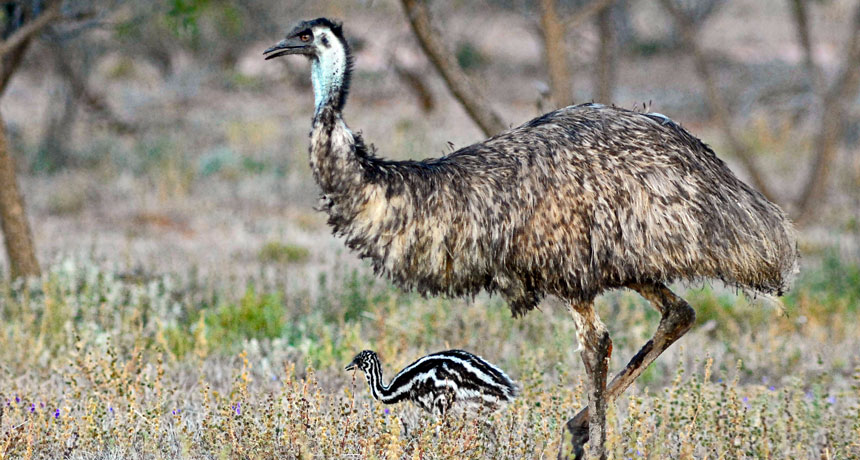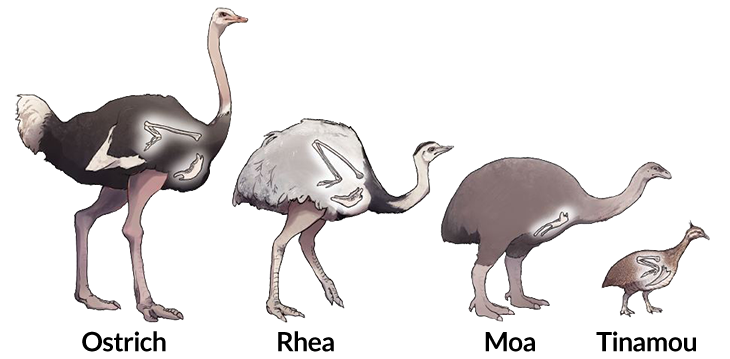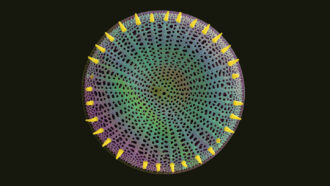How some birds lost the ability to fly
Scientists blame changes in the mysterious DNA that controls genes

Emus and their relatives may have lost the ability to fly because of changes in DNA that regulates genes. Here, an emu walks with its chick.
Graeme Chapman
Some bird species are permanently grounded. New research shows they may have evolved this way due to tweaks in DNA that bosses genes around.
Emus, ostriches, kiwis, rheas, cassowaries and tinamous all belong to a group of birds called ratites. (So do the extinct moa and elephant birds.) Of these, only tinamous can fly. Scientists studied the regulatory DNA of these birds to learn why most of them can’t fly. The researchers found that mutations in regulatory DNA caused ratites to lose flight. That happened in up to five separate branches of the birds’ family tree. The researchers reported their results April 5 in Science.
Regulatory DNA is more mysterious than the DNA that makes up genes. Studying how this bossy DNA drives evolution could shed light on how closely related species can evolve such different traits.
Bossy DNA
Genes are pieces of DNA that hold instructions for making proteins. In turn, the proteins do tasks inside your body. But regulatory DNA doesn’t carry protein-making instructions. Instead, it controls when and where genes turn on and off.
Researchers have long debated how big evolutionary changes happen, such as gaining or losing flight. Is it because of mutations — changes — to protein-making genes that are tied to the trait? Or is it mainly because of tweaks to the more mysterious regulatory DNA?
Scientists often had stressed the importance in evolution of changes in the genes that code for (or make) proteins. Examples are relatively easy to find. For instance, an earlier study suggested that mutations in a single gene shrank the wings of flightless birds known as Galápagos cormorants.
In general, mutations that change proteins are likely to do more damage than changes to regulatory DNA, says Camille Berthelot. That makes those changes easier to spot. Berthelot is an evolutionary geneticist in Paris at the French national medical research institute, INSERM. One protein may have many jobs throughout the body. “So everywhere this protein is [made], there’s going to be consequences,” she says.
By contrast, many pieces of DNA may help regulate a gene’s activity. Each piece of bossy DNA might work in only one or a few types of tissue. That means a mutation in one regulatory piece won’t do as much damage. So changes can add up in those bits of DNA as animals evolve.
But that also means it’s much harder to tell when regulatory DNA is involved in big evolutionary changes, says Megan Phifer-Rixey. She’s an evolutionary geneticist who works at Monmouth University in West Long Branch, N.J. Those pieces of DNA don’t all look alike. And they may have changed a lot from species to species.

Mapping mutations
Scott Edwards and his colleagues got around that problem by decoding the genetic instruction books, or genomes, of 11 bird species. Edwards is an evolutionary biologist at Harvard University in Cambridge, Mass. Eight of the species were flightless birds. The researchers then compared these genomes to already completed genomes from other birds. Those included flightless birds such as ostriches, white-throated tinamous, North Island brown kiwis and emperor and Adélie penguins. They also included 25 species of flying birds.
The researchers were looking for stretches of regulatory DNA that hadn’t changed much as birds evolved. That stability is a hint that this DNA is doing an important job that shouldn’t be messed with.
The scientists found 284,001 shared stretches of regulatory DNA that hadn’t changed much. Among these, 2,355 had accumulated more mutations than expected in ratites — but not in other birds. That high number of ratite mutations shows that those bits of bossy DNA are changing faster than other parts of their genomes. That might mean the bossy bits have lost their original functions.
The researchers were able to figure out when the rate of mutations had sped up — in other words, when evolution happened fastest. Those times could have been when the bossy DNA stopped doing its job and birds lost their ability to fly. Edwards’ team concluded that ratites lost flight at least three times. It may even have happened as many as five times.
Those regulatory DNA bits tended to be close to genes that help make limbs, such as wings and legs. That hints that they might tweak gene activity to make smaller wings. The team tested how well one such bossy DNA bit could turn on a gene in chicken wings when chicks were still inside their eggs. That piece of bossy DNA is called an enhancer.
The team tried one version of the enhancer from elegant-crested tinamous, a species that can fly. That enhancer turned on the gene. But when the researchers tried a version of that same enhancer from the flightless greater rhea, it didn’t work. That suggests changes in that enhancer turned off its role in wing development. And that might have contributed to rheas becoming flightless, the scientists conclude.
Flight in the family tree
Scientists are still trying to figure out the evolutionary story of ratites. Why are they all flightless except for tinamous? One hypothesis is that the ancestor of all the species had lost the ability to fly, and tinamous later got it back. However, Edwards says, “We simply don’t think that’s very plausible.” Rather, he thinks the ancestor of ratites probably could fly. Tinamous kept that ability, but related birds lost it — mostly because of changes in regulatory DNA. “My hunch is that it’s relatively easy to lose flight,” he says.
Outside of the bird family tree, flight has evolved only a few times, Edward says. It evolved in pterosaurs, in bats, and maybe a couple of times in insects. But birds have lost flight multiple times. There are no known examples of regaining flight once it has been lost, he says.
The new data do not convince Luisa Pallares. She’s an evolutionary biologist at Princeton University in New Jersey. The study asks which is more important for evolution: regulatory DNA changes or protein-coding ones. “I personally don’t see a point in doing that,” Pallares says. Both types of change happen and may be equally important in shaping evolution, she says.







